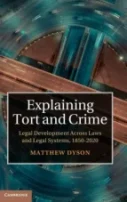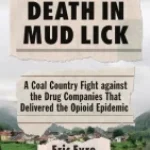Explaining Tort and Crime: Legal Development Across Laws and Legal Systems, 1850-2020
 Author: Matthew Dyson
Author: Matthew Dyson
Publisher: Cambridge University Press, 2022. 448 pages.
Reviewer: Peter Cane| September 2023
Explaining Tort and Crime is “the third outcome of a [large and ambitious] project to promote scholarship on tort and crime.”[1] The first two outcomes were edited by Matt Dyson. One dealt with various aspects of the tort law–criminal law “interaction” in English law (predominantly).[2] The other surveyed the tort-crime interaction in eight legal systems: those of England, France, Germany, Sweden, Spain, Scotland, the Netherlands, and Australia. This third volume is solely authored by Dyson. It is a mighty achievement.
Dyson examines four aspects of the interaction: concepts of fault in the two “domains”; criminal “compensation”; “timing rules” (concerned with the sequence of criminal prosecutions and tort claims based on similar facts); and the “effect of a prior criminal judgment” in a subsequent civil claim.[3] Dyson’s overarching aim is to explain development and change with regard to tort-crime interactions over a period from the mid-nineteenth century to the early twenty-first century. English law is Dyson’s starting point while the two other systems—French and Spanish—are referenced to calibrate his explanations for the developments and changes in English law over the period. Briefer references to seven other jurisdictions—Germany, Brazil, the USA, Sweden, Chile, Australia, and Scotland—provide selective “counterpoints” to the main discussions of some of the aspects covered.[4]
Dyson describes his work as “predominantly doctrinal”; although, “where possible, wider socio-economic factors have been included.”[5] Dyson is mainly concerned with the development and change of legal norms that constitute and regulate the tort-crime interaction. As Dyson uses the terms “rules” and “doctrine,” they refer not only to “positive” law, understood as “the law in the books,” but also to “the way law is carried out and experienced in practice (commonly known as ‘the law in action’)” and the “way law is conceived,” understood, and reasoned by “those who use and are bound by it” (Dyson calls this “the law in minds”).[6] At the same time, the socio-legal potential of this broad understanding of doctrine is limited by the fact that Dyson conceives of the actors involved in the creation and application of law as “legal actors”: legislators, judges (and juries), law reform bodies, legal practitioners, and legal academics.[7] Thus, the explanations Dyson gives for legal change and development tend to be internal to the legal system and (as Dyson himself says) rarely refer to the operation of forces external (in some sense) to the law. Consider, for instance, Dyson’s account of the development of criminal compensation in the mid-twentieth century, which focuses on the legal mechanics of this development; although he mentions a new, general concern with the place of victims in the criminal process, he does not explore the origins or drivers of the so-called “victims’ movement,” as Paul Rock did.[8] (This is an observation, not a criticism.)
In Chapter 3, Dyson deals with the development of the concepts of fault in criminal law and tort law at much greater length than the other three aspects of the tort-crime interaction; and he devotes much more space to discussing English law than to analysing or comparing other legal systems. The broad story Dyson tells about the development of fault in English criminal law is one of a transition from ‘moralised’ notions such as motive, malice, and wickedness to ‘state of mind’ (‘mens rea’) concepts such as intention and recklessness, subjectively understood. Dyson also detects a shift from ideas of (subjective) “responsibility” to “the less normative” and “more abstract” concept of “liability.”[9] In the twentieth century, this transition was accompanied by dramatic growth of strict liability, regulatory offences (liability regardless of fault) and, to a lesser extent, crimes of negligence. As engines of such changes, Dyson particularly identifies scholarship (from the mid-twentieth century), judicial reasoning, and legislative regulation in criminal rather than civil mode.
Dyson’s tort story, in Chapter 4, is messier. The most notable development here has been the emergence of negligence—understood objectively as a breach of a duty of care—as the dominant standard for tort liability. Whereas motive and purpose were purged from criminal liability (as opposed to sentencing), they have remained in small pockets of tort law. Subjective intent (which is not distinguished from subjective recklessness) plays a role in a few so-called ‘economic’ torts. Strict liability plays a much smaller role in tort law than it has come to play in criminal law (as a result of legislation). As engines of change, academics and legislatures appear less in Dyson’s tort story than they do in his account of criminal law.
In Chapter 5, Dyson “draws together explanations for some of the key developments” discussed Chapters 3 and 4.[10] In this chapter and throughout the book, Dyson divides his explanations into three parts focusing, respectively, on ‘issues,’ ‘processes,’ and ‘outcomes.’ Issues refers to doctrinal matters at the tort-crime interface: that is, in this context, various aspects of the broad concept of fault. Outcomes refers to the answers to doctrinal questions that emerged from the developments and changes that Dyson traces. To my mind, these two foci do not yield explanations so much as differently oriented analyses of what Dyson sets out to explain—namely, doctrinal change at the tort-crime interface. Outcomes has a specific temporal reference (the end of the period of development) that issues lacks. The issues section ranges more widely over the selected period as a whole. The result is a certain degree of distracting, and sometimes confusing, repetition.
There is much more explanatory meat in the processes section. The explanations are ‘internal’ but fruitful because they refer to structures and processes rather than substantive doctrine. For instance, Dyson discusses the possible impact on English fault doctrine of the decline of private prosecution, removal of witness disqualification rules, and allocation of criminal and civil jurisdictions to different sets of courts (in contrast to the French system).[11] Dyson also considers the possible impact of, for instance, the abolition of civil juries, the heavy involvement of lay judges and juries in the English criminal justice system, the abolition of the forms of action, and the role of scholars in the legal system.[12]
Indeed, I suggest that the best way to read Explaining Tort and Crime is as a longitudinal study of the impact of institutional structures and processual mechanics of legal systems on doctrine. In this reading, the tort-crime interface provides an illuminating case study but is not what the book is primarily about. Dyson sets out to explain the contemporary doctrinal shape of the tort-crime interface in English law primarily through factors internal to the legal system. Both historical, cross-temporal and comparative, cross-jurisdictional research methods are tried and tested ways of illuminating doctrinal features of a target legal system that might appear very difficult to explain by looking at the target system in isolation. In the process, much can be learned and explained about the comparator systems.
The plausibility of this reading of Explaining Tort and Crime is well supported by Part III, entitled “Procedures Interfacing Tort and Crime.” It deals with three matters: the powers of criminal courts to award compensation (Chapter 6); the sequencing (timing) of criminal and civil actions arising from the same set of facts (Chapter 7); and the “effect of prior convictions on later civil claims” (Chapter 8). In each case, it is plausible to hypothesise that procedural differences between systems at the tort-crime interface might affect or reflect doctrinal features of tort law and criminal law respectively.
The critical distinction seems to be between systems (such as the English) in which different sets of courts have jurisdiction respectively over criminal proceedings and civil claims based on the same set of facts; and, by contrast, systems (such as the French) in which criminal courts have jurisdiction over related civil claims. In the latter case, the system allows “joint action: a civil claim brought inside the criminal prosecution for damage directly caused to the person aggrieved.”[13] Intuitively, in a system that does not recognise joint actions, it might be expected that methods other than recourse to a criminal court (such as the Criminal Injuries Compensation Scheme) would figure prominently as avenues for compensation for the consequences of crime. It might also be expected that: the joined action would favour approximation of fault standards in criminal law and civil law; the issue of sequencing would present itself differently in a system that does not recognise joint action as compared with one that does; and the effect of a prior criminal conviction on a later civil claim would vary as between the two types of system. There is much fascinating material in Part III of Explaining Tort and Crime for testing such intuitions.
In Chapter 9, Dyson identifies six patterns of development that, he claims, have emerged from consideration of the tort/crime interface. As I read them, the first and second elaborate the idea that structure and process may affect doctrinal development.[14] In the third pattern, “ambiguity, uncertainty and malleability” of legal doctrine may provide opportunities for doctrinal change.[15] In the fourth, the respective roles of various legal actors (such as judges and legislatures) and how the nature of the interactions between them from time to time may be important for explaining doctrinal change.[16] In the fifth pattern, explanation of legal development being assisted by the “periodisation” of historical time.[17] In different contexts throughout the book, Dyson suggests various periodisations as being explanatorily helpful. The sixth pattern identifies three concepts that may be useful in explaining doctrinal stability and change: path dependence, feedback mechanisms, and transplants.[18] This chapter covers a great deal of significant and difficult theoretical and methodological terrain. Part of me (lazily) wishes that Dyson had introduced these patterns at the beginning of the book as hypotheses about doctrinal change and systematically organised his material, both historical and comparative, around testing them.
Finally, I want to suggest a few matters to which, I think, more attention might fruitfully be paid. The first is the distinction between common law and civil law legal systems. I am conscious that this is a controversial distinction that needs to be carefully handled. However, the contrast between the English common law and the French and Spanish civil law systems is built into Dyson’s project. I wonder whether it might be relevant in certain ways to understanding doctrinal formulation and development. Second, as Dyson recognises, the abolition of the forms of action and civil juries profoundly affected English tort doctrine and scholarship and deserves close attention. Notably, by contrast, criminal law stood outside the formulary system and was unaffected by the abolition of writs. Related, I suspect, is the fact that unlike criminal law scholarship, tort scholarship has never adopted the distinction between the general and special parts. More systematic analysis might be illuminating. A final, minor point: in various places, Dyson distinguishes between “moralised” and “legal/doctrinal” concepts of fault.[19] This strikes me as a false dichotomy. For instance, one might describe responsibility/liability for intentional wrongdoing as both a moral and a legal principle. Space prevents further discussion of the very difficult topic of the relationship between law and morality.
Explaining Tort and Crime is a terrific book, and we are deeply in Matt Dyson’s debt. Not only does it realise the ambition of promoting scholarship on tort and crime, it also makes a major contribution to the literature on doctrinal development and change in the law. It has taught me a great deal. One can ask and expect no more.
References:
Paul Rock, Constructing Victims’ Rights: The Home Office, New Labour, and Victims (2004)
Peter Cane is an Emeritus Professor at Australian National University College of Law.
[1] Matthew Dyson, Explaining Tort and Crime: Legal Development Across Laws and Legal Systems 1850–2020 xi (2022).
[2] Id. at 15.
[3] Id. at 14-15, 405.
[4] Id. at 347.
[5] Id. at 4.
[6] Id. at 6-7.
[7] Id. at 461.
[8] Paul Rock, Constructing Victims’ Rights: The Home Office, New Labour, and Victims (2004).
[9] Dyson, supra note 1, at 105, 223.
[10] Id. at 202.
[11] Id. at 241, 250-64, 290-92.
[12] Id. at 242-46.
[13] Id. at 317.
[14] Id. at 451-59.
[15] Id. at 459-61.
[16] Id. at 461-65.
[17] Id. at 465-71.
[18] Id. at 471-75.
[19] Id. at 220.


